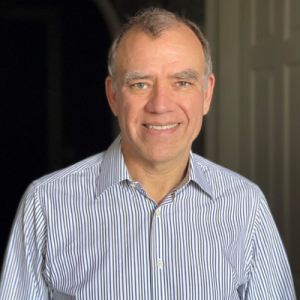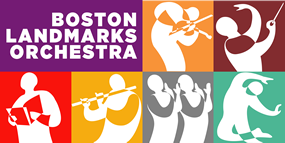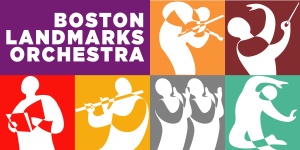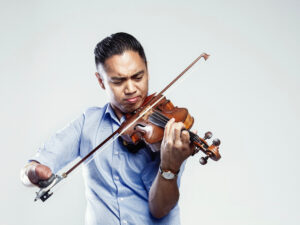by Christopher Wilkins
In Mozart and More at Peoples Baptist Church, Adrian Anantawan solos in two works; both are arrangements for violin and strings of works originally composed for other forces. The first is Adoration, a prayer-like meditation written for solo organ by Florence Price. Then comes Astor Piazzolla’s brilliant “Summer” from The Four Seasons of Buenos Aires (Cuatro Estaciones Porteñas). Piazzolla performed and recorded all four “seasons”—tango-inspired pieces—several times with his quintet. But they have become enormously popular in recent years in arrangements by Leonid Desyatnikov. The four movements, each under ten minutes long, quote from Vivaldi‘s The Four Seasons.
Wolfgang Amadè Mozart was eighteen years old when he composed his sublime Symphony No. 26. This masterpiece forms the nucleus of the “Mozart” portion of the evening. Opening the program is another terrific, lesser-known youthful work, his overture to the opera Lucio Silla, composed when he was just 16.
Tonight’s concert is a tale of two halves. The first half comprises music by Mozart; the second is all music of the Americas. Eubie Blake’s Shuffle Along, with lyrics by Noble Sissle, opened in 1921 on West 62nd St in New York. The all-Black cast musical was so successful that New York City permanently changed the traffic patterns in the San Juan Hill neighborhood on the West Side to accommodate the huge influx of theatergoers eager to see the show. Shuffle Along not only altered the racial success formula on Broadway, it also changed forever the course of American popular music. Artists as diverse as George Gershwin, Al Jolson, and Langston Hughes heralded the arrival of a new sound in American musical theater.
Arturo Márquez’s Danzón No. 2 has rapidly become one of the most frequently performed orchestral works by any living composer. It is admired—adored even—throughout the world for its propulsive rhythms, sweeping lines, irresistible sensuality, and the warmth of its Cuban-Mexican soul. One of its delights is the orchestration, which includes wonderfully idiomatic solos for clarinet, oboe, piano, violin, trumpet, and piccolo.
In the following conversation, Adrian Anantawan speaks with me about his career and his performance with the Landmarks Orchestra:
CW: We’re all excited to have you with us next week, Adrian. It will be a full week, to say the least. But I know you always have lots going on. What’s happening with you right now?
AA: This is Shelter Music week. I’m playing duets with a wonderful tuba player, Eric Goode. We’re doing Chopin Nocturnes, the Bach Double, some fiddle tunes, and repertoire that’s just kind of all over the place! Eric’s a great player. He’s also a teaching assistant with me at Milton Academy, and the Children’s Program Director at Shelter Music. We do one or two children’s sites a month at Shelter Music. We have six regular adult partner sites, and two for the children. Consistency is key.
CW: You’ve worked with the Landmarks Orchestra in so many different capacities: as soloist, conductor, and teacher. Next week you appear in your role as Artistic Director of Shelter Music. In addition, you’ve influenced us in your work in the abilities space, as an advocate, advisor, and as a scholar. How does applying so many different skills allow you to realize your goals as an artist?
AA: I think I’ve just always wanted to do some good in the world. It’s a very personal thing, because I could easily have been someone who didn’t have access to music because I needed an adaptation in order to play the violin. I wouldn’t be performing today if it wasn’t for a confluence of factors, including a music teacher— a childhood instructor in Canada—and engineers working together to develop how I could play the instrument.
CW: That early support must have been remarkable, because you got into the Curtis Institute of Music in Philadelphia, arguably the most prestigious music school in the world. No doubt you received exceptional training there in musical performance. But did they also support you in pursuing the things you were interested in as your life mission?
AA: Curtis was a wonderful experience. I got to play with some of the future stars in the field—it was a blessing. At the time, Curtis didn’t really have a robust understanding of how to encourage musicians to make an impact through the knowledge translation field.
Yet, interestingly, there were a lot of people in my cohort—like Stan Thompson, for instance—working on issues of access. So I was aware of an appetite to do that amongst my peers, to impact community as related to our specific identities. I think that the Curtis Institute of today is a different institution, constantly looking for new ways to foster accessibility.
CW: Landmarks programming is always eclectic. Drawing from many different traditions helps us connect to the diverse populations of Boston. The program we’re doing together next week is a great example— it’s incredibly diverse. What role does programming play in serving the mission of Shelter Music?
AA: The two organizations definitely align in terms of exploring the diverse range of composers who write currently, and have written throughout the past. The point is to reflect the populations we’re serving. With Shelter Music, like most organizations, it’s how you balance it. If you’re new to classical music and you’re listening to Mozart for the first time, then that’s new and exciting, and that should be celebrated.
But every year we also have special projects that bring new works into the world, music that is especially applicable to the world we live in. A couple years ago, we commissioned composers to set music to poetry written by individuals who are experiencing homelessness. We collected pieces of music that were meaningful to them—”Eye of the Tiger,” for instance—and then created new works based on these songs. Playing them back to the audience, they hear their favorite songs in fresh and interesting ways. It’s a great way to create conversations that go deeper with these communities.
We’re currently working on a different project in partnership with Carnegie Hall and one of our partner sites where we create lullabies for moms—songs that reflect and amplify their stories. In the context of homelessness, we constantly see a narrative of “fear of othering.” Art can be a direct resistance to that. Music in particular has this power.
In terms of who performs with Shelter Music, the musicians we invite are folks who engage well with our audiences no matter who they are. The idea is to minimize barriers, to create spaces for conversation, which are as important—in some cases more important—than the music itself. And we have ensemble leaders in our monthly programming who guide newer musicians to engage in this work.
CW: We will perform in five different venues: the Hatch Shell, three neighborhood venues, and the Pine Street Inn. Performing in a shelter will be a first for us. Tell us what you’re learned about making music in such varied settings.
AA: We visit the Pine Street Inn every month. This program will be for men who are going through recovery from substance use. In the Shattuck facility, there is an attached shelter as well. We’ve had incredibly moving interactions with these men. Some of them will go deeply into their relationships with music. One might say, for instance, that he has a musical background, but doesn’t currently have access to a musical instrument. Bringing live music into the space changes the relational dynamic in a crucial way.
There is a lot of difficult and powerful work that contributes to recovery. Music can help alleviate the toughness throughout the day. But it can also provide a platform for discussion as we form new bonds. To encourage dialogue, we typically plan a shorter program. That’s true for next week’s program with Landmarks musicians at the Pine Street Inn. The musical portion is truncated because we want to add to the experience a robust back-and-forth with the audience.
CW: It’s such important work, Adrian. And you’re helping us all conceive how to do it usefully. Where would you like to go next with all of this as your career develops?
I would love to be able to help shift our thinking about disability in classical music—to view it as its own culture that can be celebrated. I’m interested in creating spaces for would-be musicians who are currently disabled but don’t disclose it, because there’s a stigma around the perception of not being capable. I would like to continue working with young people who have disabilities, supporting their development and confidence. That’s where I find my passion.
I’d like to travel and see other programs in Asia, in Europe, and play music and just use my gifts and whatever I can do from my unique vantage to create positive impact. And then, while I can, to perform and just express myself, always championing the incredible things that are happening in the world around these intersections. They can be difficult to see because we tend to work in isolation.
CW: The performing piece is key. It’s the draw. It’s what creates the beauty and the energy that attracts people to the experience and makes them want to be a part of it. But you’re also showing the way. You’re opening up a path for people who may not see it as available to them. It’s exciting for us at Landmarks to work with you on so many levels, as it has been well over decade now. Thank you for your time. We can’t wait for our work together next week!
AA: I’m really excited about it.
CW: And for more information?
AA: For more information, people can go to my website or Shelter Music’s website. They can also check out the work I’m doing at Berklee with the Music Inclusion Ensemble, which is awesome.
 CHRISTOPHER WILKINS was appointed Music Director of the Boston Landmarks Orchestra in the spring of 2011. Since then, he has expanded the orchestra’s mission of making great music accessible to the whole community. He has also helped develop the orchestra’s Breaking Down Barriers initiative, making accessibility a priority in all aspects of the orchestra’s activities.
CHRISTOPHER WILKINS was appointed Music Director of the Boston Landmarks Orchestra in the spring of 2011. Since then, he has expanded the orchestra’s mission of making great music accessible to the whole community. He has also helped develop the orchestra’s Breaking Down Barriers initiative, making accessibility a priority in all aspects of the orchestra’s activities.


